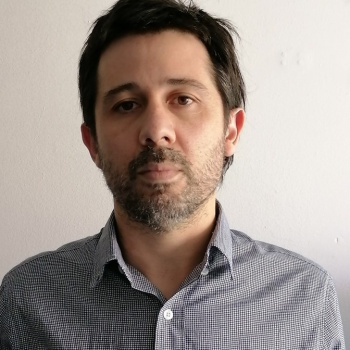Young Investigator at Centro Interdisciplinario de Neurociencia de Valparaíso.
Contact information:
E-mail: ignacio.diaz@cinv.cl
Pasaje Harrington 287 Playa Ancha. Valparaíso, Chile.
Phone: (56)-(32)-2508040
Living organisms are continuously exposed to mechanical stress, which is detected by mechanosensitive proteins responsible for triggering metabolic or electrochemical responses at the cellular or tissue level. Mechanosensitive ion channels (MSCs) are part of this group, participating in several key physiological responses such as the sense of touch, proprioception, cell differentiation, the vascular system and the immune response. Recently, the structure of several MSCs have been resolved by Cryo-EM. Unlike other molecular sensors, such as voltage-gated ion channels or thermo-TRP, MSCs do not exhibit homology at the sequence or structure level. Thus, our group seeks to understand how such different molecular scaffolds give rise to similar responses. Specifically, our objective is to provide a detailed description of the force sensing process and mechanochemical transduction pathway of MSC’s Piezo1/2 and OSCA. For this, we combined patch clamp recording, rate-equilibrium linear free energy relationships, unnatural amino acid fluorescence, and molecular simulations to get a description of the phenomenon at the molecular level. We hope these findings contribute to a better understanding of how mechanical forces shape cell and tissues dynamics in health and disease.
- Ignacio Díaz-Franulic*, Natalia Raddatz, Karen Castillo, Fernando González-Nilo and Ramón Latorre. A Folding Reaction at the C-Terminal Domain Drives Temperature Sensing in TRPM8 Channels. Proc Natl Acad Sci U S A 2020 Aug 3;202004303. doi: 10.1073/pnas.2004303117. *Co-Corresponding Author
- Moldenhauer H, Díaz-Franulic I, Poblete H, Naranjo D. Trans-toxin ion-sensitivity of charybdotoxin-blocked potassium-channels reveals unbinding transitional states. Elife. 2019 Jul 4;8. pii: e46170. doi: 10.7554/eLife.46170.
- Díaz-Franulic I*, González-Pérez V, Moldenhauer H, Navarro-Quezada N, Naranjo D. Gating-induced large aqueous volumetric remodeling and aspartate tolerance in the voltage sensor domain of Shaker K+ channels. Proc Natl Acad Sci U S A. 2018 Aug 7;115(32):8203-8208 *Co-Corresponding Author
- Naranjo D, Moldenhauer H, Pincuntureo M, Díaz-Franulic I*. Pore size matters for potassium channel conductance. J Gen Physiol. 2016 Oct;148(4):277-91. *Co-Corresponding Author
- Díaz-Franulic I*, Caceres-Molina J, Sepulveda RV, Gonzalez-Nilo F, Latorre R. Structure-Driven Pharmacology of Transient Receptor Potential Channel Vanilloid 1. Mol Pharmacol. 2016 Sep;90(3):300-8. doi: 10.1124/mol.116.104430. *Co-Corresponding Author
- Diaz-Franulic I*, Poblete H, Miño-Galaz G, González C, Latorre R. Allosterism and Structure in Thermally Activated Transient Receptor Potential Channels. Annu Rev Biophys. 2016 Jul 5;45:371-98. *Co-Corresponding Author
- Moldenhauer H, Díaz-Franulic I, González-Nilo F, Naranjo D. Effective pore size and radius of capture for K(+) ions in K-channels.Sci Rep. 2016 Feb 2;6:19893
- Díaz-Franulic I, Sepúlveda RV, Navarro-Quezada N, González-Nilo F, Naranjo D. Pore dimensions and the role of occupancy in unitary conductance of Shaker K channels. J Gen Physiol. 2015 Aug;146(2):133-46. Cover Issue



